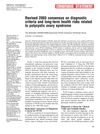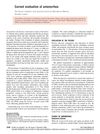Current Evaluation of Amenorrhea
October 2006
in “
Fertility and Sterility
”

TLDR The document concludes that identifying the cause of amenorrhea is crucial for proper treatment.
The 2006 document by the Practice Committee of the American Society for Reproductive Medicine provides an overview of the evaluation of amenorrhea, distinguishing between primary and secondary amenorrhea and noting a prevalence of 3% to 4% for non-pregnancy, non-lactation, and non-menopause related cases. It identifies polycystic ovary syndrome, hypothalamic amenorrhea, hyperprolactinemia, and ovarian failure as the most common causes. The evaluation process includes a history and physical examination, along with measurement of FSH, TSH, and prolactin levels. The document highlights the need for a karyotype in women under 30 with ovarian failure and the consideration of autoimmune and genetic factors in premature ovarian failure. It also discusses the differentiation between hypothalamic amenorrhea and PCOS, the risk of osteoporosis, and the potential need for estrogen-progestin therapy or ovulation induction. Screening for type 2 diabetes in women with PCOS is recommended, emphasizing the importance of identifying the underlying cause of amenorrhea for appropriate treatment.

